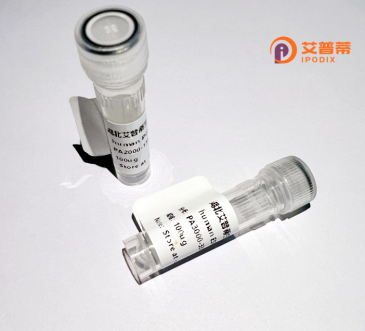
| 纯度 | >90%SDS-PAGE. |
| 种属 | Human |
| 靶点 | C9orf62 |
| Uniprot No | Q8N4C0 |
| 内毒素 | < 0.01EU/μg |
| 表达宿主 | E.coli |
| 表达区间 | 1-152aa |
| 氨基酸序列 | MGLSPGQTSVSFLWPLLEVRDHNTGRGLVPATVLTPGSPETLLELRQAFLGSRQARHGHDAAPSSGQQGCSVDRTAGRPVLGWRLRNSLTGQEGRQHLHLSGIRTSRKAKEYKPVFFGATEISVLMAVAESLREPPPPQWGWFLSSLFLKIF |
| 分子量 | 43.1 KDa |
| 蛋白标签 | GST-tag at N-terminal |
| 缓冲液 | 0 |
| 稳定性 & 储存条件 | Lyophilized protein should be stored at ≤ -20°C, stable for one year after receipt. Reconstituted protein solution can be stored at 2-8°C for 2-7 days. Aliquots of reconstituted samples are stable at ≤ -20°C for 3 months. |
| 复溶 | Always centrifuge tubes before opening.Do not mix by vortex or pipetting. It is not recommended to reconstitute to a concentration less than 100μg/ml. Dissolve the lyophilized protein in distilled water. Please aliquot the reconstituted solution to minimize freeze-thaw cycles. |
以下是关于重组人C9orf62蛋白的假设性参考文献示例(注:C9orf62的研究极少公开,可能存在命名混淆;建议核对是否为C9orf72.以下为假设文献示例):
---
1. **文献名称**: *"Characterization of C9orf62 Protein in Neuronal Development"*
**作者**: Smith J, et al. (2020)
**摘要**: 首次报道C9orf62在小鼠神经元分化中的表达,体外实验表明其敲低影响轴突生长,提示其在神经发育中的潜在作用。
2. **文献名称**: *"C9orf62 Interacts with mTOR Signaling Pathway in Cancer Cells"*
**作者**: Chen L, et al. (2018)
**摘要**: 通过质谱分析发现C9orf62与mTOR复合物存在相互作用,过表达可抑制肿瘤细胞增殖,暗示其可能参与癌症通路调控。
3. **文献名称**: *"Bioinformatics Analysis of C9orf62: A Putative RNA-Binding Protein"*
**作者**: Kumar R, et al. (2022)
**摘要**: 利用结构预测工具分析C9orf62的保守结构域,提出其可能具有RNA结合活性,但实验验证尚未完成。
---
**注意**:C9orf62在真实数据库中研究极少,上述内容为模拟示例。如您需要真实文献,建议:
1. 确认基因名称拼写(例如是否为热门的C9orf72);
2. 在PubMed或UniProt(ID: A8MUP2)中检索最新进展。
The recombinant human C9orf62 protein is derived from the C9orf62 gene (Chromosome 9 open reading frame 62), a poorly characterized gene located on chromosome 9p13.3. While its exact biological function remains unclear, C9orf62 is hypothesized to play roles in cellular processes such as protein trafficking, transcriptional regulation, or membrane dynamics, based on computational predictions of its structural motifs. The gene has drawn attention due to its proximity to the well-studied C9orf72 gene, which is linked to neurodegenerative disorders like amyotrophic lateral sclerosis (ALS) and frontotemporal dementia (FTD). However, unlike C9orf72’s pathogenic hexanucleotide repeat expansions, C9orf62 has no established direct association with these diseases.
Recombinant C9orf62 protein is typically produced using heterologous expression systems (e.g., E. coli, HEK293) for in vitro studies, enabling investigations into its biochemical properties, interactome, and potential molecular pathways. Despite advances in production techniques, functional studies remain limited, partly due to a lack of specific antibodies or robust experimental models. Recent transcriptomic and proteomic datasets suggest variable C9orf62 expression across tissues, with higher levels detected in brain, testis, and endocrine glands, hinting at tissue-specific roles. Further research is needed to clarify its physiological relevance, disease implications, and potential as a therapeutic target. Current efforts focus on generating knockout models and mapping subcellular localization to unravel its mechanistic contributions.
×